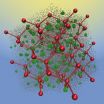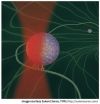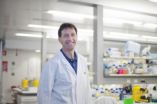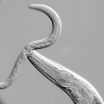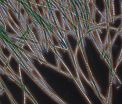(Press-News.org) In developing these novel self-assembling materials, postdoc Barbara Capone has focused on the design of organic and inorganic building blocks, which are robust and can be produced at large scale. Capone has put forward, together with her colleagues at the Universities of Vienna and Mainz, a completely new pathway for the construction of building blocks at the nanoscale.
"Soft Lego" orders in crystal structures
The team of researchers has shown that so-called block copolymer stars – that means polymers that consist of two different blocks and they are chemically anchored on a common point – have a robust and flexible architecture and they possess the ability to self-assemble at different levels. At the single-molecule level, they first order as soft patchy colloids which serve then as "soft Lego" for the emergence of larger structures. At the next level of self-assembly, the colloids form complex crystal structures, such as diamond or cubic phases.
The spatial ordering in the crystals can be steered through the architecture of the "soft Lego" and opens up the possibility for the construction of new materials at the macroscopic scale with desired structure. In this way, crystals can be built that have applications in, e.g., photonics, acting as filters for light of certain frequencies or as light guides.
INFORMATION:
Publication:
Telechelic Star Polymers as Self-Assembling Units from the Molecular to the Macroscopic Scale. Barbara Capone, Ivan Coluzza, Federica LoVerso, Christos N. Likos, and Ronald Blaak. In: Physical Review Letters. Dezember 2012. DOI: 10.1103/PhysRevLett.109.238301.
http://prl.aps.org/abstract/PRL/v109/i23/e238301
Scientific contacts
Dr. Barbara Capone
Computational Physics
University of Vienna
1090 Wien, Sensengasse 8
http://homepage.univie.ac.at/barbara.capone/
Univ.-Prof. Dipl.-Ing. Dr. Christos N. Likos
Computational Physics
University of Vienna
1090 Wien, Sensengasse 8
T 43-1-4277-732-30 (oder: -73231)
christos.likos@univie.ac.at
Press Contact
Mag. Veronika Schallhart
Press Office of the University of Vienna
Research and teaching
1010 Wien, Universitätsring 1
T 43-1-4277-175-30
veronika.schallhart@univie.ac.at
Soft Lego built in the computer
2013-01-17
ELSE PRESS RELEASES FROM THIS DATE:
Vaginal delivery is the safest option for women with pelvic girdle pain
2013-01-17
Caesarean section increases the risk of persistent pelvic girdle pain after delivery compared with vaginal delivery, according to a new study from the Norwegian Institute of Public Health.
Caesarean section rates are increasing worldwide, and this trend has partly been explained by women's requests for planned caesarean section without a medical reason. Pregnancy-related pelvic girdle pain has been associated with increased preference for caesarean section and with increased planned caesarean section rates.
"Some women with severe pelvic girdle pain might fear that ...
A nano-gear in a nano-motor inside you
2013-01-17
To live is to move. You strike to swat that irritable mosquito, which skilfully evades the hand of death. How did that happen? Who moved your hand, and what saved the mosquito? Enter the Molecular Motors, nanoscale protein-machines in the muscles of your hand and wings of the mosquito. You need these motors to swat mosquitoes, blink your eyes, walk, eat, drink... just name it. Millions of motors tug as a team within your muscles, and you swat the mosquito. This is teamwork at its exquisite best.
Paradoxically, a weak and inefficient motor (called dynein) is the one that ...
A hidden treasure in the Large Magellanic Cloud
2013-01-17
Nearly 200 000 light-years from Earth, the Large Magellanic Cloud, a satellite galaxy of the Milky Way, floats in space, in a long and slow dance around our galaxy. Vast clouds of gas within it slowly collapse to form new stars. In turn, these light up the gas clouds in a riot of colours, visible in this image from the NASA/ESA Hubble Space Telescope.
The Large Magellanic Cloud (LMC) is ablaze with star-forming regions. From the Tarantula Nebula, the brightest stellar nursery in our cosmic neighbourhood, to LHA 120-N 11, part of which is featured in this Hubble image, ...
Potential new treatment for gastrointestinal cancers discovered
2013-01-17
Researchers have identified a complex of proteins that promotes the growth of some types of colon and gastric cancers, and shown that medications that block the function of this complex have the potential to be developed into a new treatment for these diseases.
The complex of proteins, known as mTorc1 (mammalian target of rapamycin complex 1), has previously been implicated in the development of some other cancers but this is the first time it has been shown to promote the growth of colon and gastric cancers that are associated with inflammation.
Dr Stefan Thiem and ...
Amputations among people with diabetes can be reduced by 50 percent
2013-01-17
Every 30 seconds somebody in the world is amputated as a consequence of foot complication due to diabetes. A new study at Sahlgrenska Academy, University of Gothenburg, Sweden, confirmes that shoe inserts, podiatry, regular checkups and other simple interventions can reduce the number of amputations by more than 50%.
Orthotic researchers at Sahlgrenska Academy, University of Gothenburg, have studied diabetic foot complications ever since 2008. They have focused on protecting the foot from overloading the foot sole in order to minimize the risk of ulcers, which may eventually ...
The neurobiological consequence of predating or grazing
2013-01-17
This press release is available in German.
Researchers in the group of Ralf Sommer at the Max Planck Institute for Developmental Biology in Tuebingen, Germany, have for the first time been able to identify neuronal correlates of behaviour by comparing maps of synaptic connectivity, or "connectomes", between two species with different behaviour. They compared the pharyngeal nervous systems of two nematodes, the bacterial feeding Caenorhabditis elegans and the predator/omnivore Pristionchus pacificus and found large differences in how the neurons are "wired" together.
A ...
Study offers new insights into the mechanics of muscle fatigue
2013-01-17
A study in The Journal of General Physiology examines the consequences of muscle activity with surprising results, indicating that the extracellular accumulation of potassium that occurs in working muscles is considerably higher than previously thought.
Muscle excitation involves the influx of sodium ions and efflux of potassium ions. Although the fraction of ions that cross the muscle membrane with each contraction is minute, repeated activity can lead to substantial changes in the intracellular and extracellular concentrations of sodium and potassium ions. The extent ...
Pediatric coding top tips and pediatric CPT changes 2013
2013-01-17
Cyanobacteria belong to the Earth's oldest organisms. They are still present today in oceans and waters and even in hot springs. By producing oxygen and evolving into multicellular forms, they played a key role in the emergence of organisms that breathe oxygen. This has, now, been demonstrated by a team of scientists under the supervision and instruction of evolutionary biologists from the University of Zurich. According to their studies, cyanobacteria developed multicellularity around one billion years earlier than eukaryotes – cells with one true nucleus. At almost the ...
People with low risk for cocaine dependence have differently shaped brain to those with addiction
2013-01-17
People who take cocaine over many years without becoming addicted have a brain structure which is significantly different from those individuals who developed cocaine-dependence, researchers have discovered. New research from the University of Cambridge has found that recreational drug users who have not developed a dependence have an abnormally large frontal lobe, the section of the brain implicated in self-control. Their research was published in the journal Biological Psychiatry.
For the study, led by Dr Karen Ersche, individuals who use cocaine on a regular basis underwent ...
Cheating to create the perfect simulation
2013-01-17
(Jena) The planet Earth will die – if not before, then when the Sun collapses. This is going to happen in approximately seven billion years. In the universe however the death of suns and planets is an everyday occurance and our solar system partly consists of their remnants.
The end of stars – suns – rich in mass is often a neutron star. These "stars' liches" demonstrate a high density, in which atoms are extremely compressed. Such neutron stars are no bigger than a small town, but heavier than our sun, as physicist PD Dr. Axel Maas of the Jena University (Germany) points ...
